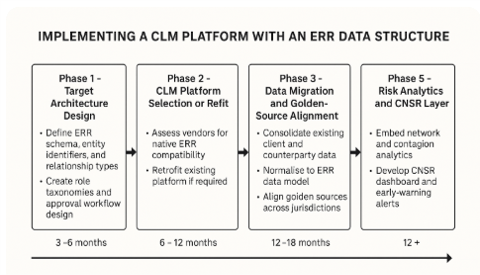The Next Evolution of Client Risk Management
CNRM extends Entity Client Lifecycle Management (E-CLM) to the network level — enabling banks to see, assess, and act on risk across connected clients, counterparties, and jurisdictions.
From Entity to Network Awareness
Traditional CLM systems manage client entities. CNRM expands this to manage the client’s network — the entities, roles, and relationships through which real-world risk moves.
It unites operational, data, and risk disciplines so banks can recognise exposures, dependencies, and opportunities across connected clients
The CNRM Capability Stack
5 layers make up the capability stack for client network risk management:
Foundation — Purpose and Governance
Defines why the bank needs network-level awareness and the principles that guide its design.
Structural — Data and Classification
Establishes the Entity-Role-Relationship (ERR) data architecture, taxonomies, and controls that link clients across systems and jurisdictions.
Operating — Processes and Integration
Runs the core client lifecycle, ingesting and maintaining network data within onboarding, KYC, and ongoing due diligence workflows.
Execution — Monitoring and Control
Applies analytics, screening, and workflow oversight to detect and respond to network risks in real time.
Outcome — Resilience and Insight
Delivers network-aware risk decisions that strengthen compliance, operational efficiency, and client trust.
CNRM builds on E-CLM
E-CLM provides entity integrity, process control, and compliance efficiency.
CNRM extends it — connecting entities and enabling the bank to manage risk and opportunity through network-level intelligence.
Client Network Risk Management (CNRM) integrates data from CLM, risk, and operations into a single structural control capability for the financial institution.
Why It Matters
In an era of fragmented global value chains, client risk is network risk.
Banks that can interpret client networks can foresee contagion, anticipate stress, and strengthen their global relevance.
Without it, they face rising operational blind spots, fragmented risk coverage, and potential client attrition to more network-aware competitors.
Implementing CNRM
Assess the existing CLM platform readiness for ERR-based architecture
Define the data model and taxonomy for entity-role-relationship
Integrate network analytics and external data sources
Align governance and operating model
Establish a five-year transformation roadmap
Implementing CNRM is a significant journey with the following suggested as starting points.




